Biostar iDEQ 200T: Great Performance & Brilliant Design
by Wesley Fink on September 29, 2003 10:24 PM EST- Posted in
- Systems
Biostar iDEQ 200T: iDEQ Chassis
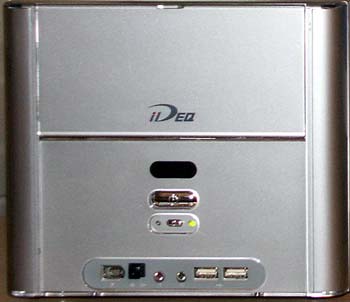
Biostar has taken the elegant cube idea to another level with the iDEQ chassis. The iDEQ chassis front appears to be brushed Aluminum and closed.
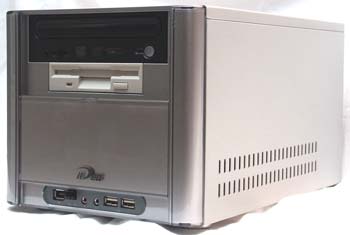
It is really a sliding plastic door designed to conceal the Optical and floppy drives until they are needed. Front ports are a very complete collection of Firewire, USB, SPDIF Optical IN, and Mic and Headphone mini jacks. Two front panel features show the attention to detail by Biostar: the front SPDIF IN port (and Rear OUT), and the slightly translucent sliding panel, which still allows operation LEDs to shine through even when covered.

The rear of the chassis is also thoughtfully designed. The iDEQ 200T includes 3 audio jacks easily configured for use with 6 speakers, SPDIF Optical OUT, PS2 mouse and keyboard ports, serial, VGA, firewire, 10/100 LAN, and 2 USB 2.0 ports. The 3 audio jacks can be easily configured to drive a 6-speaker audio system, while still retaining the front mic and headphone jacks. Also notice the punchouts for mounting a Parallel Port, Game Port, and additional Serial Port from internal headers. It has been very difficult to find even an optional Parallel Port on SFF machines, and the game port header is tuly unusual. Unlike some other SFF designs that seem to have “small” as their only design goal, the Biostar was clearly designed with a great deal of thought as to how a computer user really works and how they might use peripherals and ports.

The brushed aluminum shell includes air inlet grills low on both sides of the chassis, which assist airflow for cooling.

Instead of a bulky one-piece chassis cover, Biostar has used separate side and top panels for the iDEQ chassis. While this is a very good idea, be aware that the side panels should be removed before you attempt to remove the top panel.
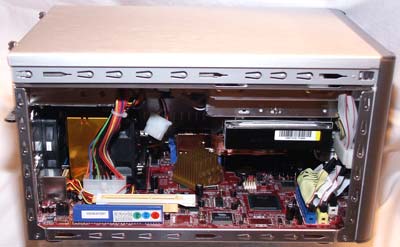
As you can see in our open view of the chassis, we have loaded the Biostar system with a CD Recorder/DVD combo, floppy, and a 120 Gb hard drive. Even with all of these peripherals installed, the interior is still well-organized and uncluttered, especially considering the small size of the system.
You can see that the AGP 8X and PCI slot, are accessible from the left side, but you may not notice that the AGP slot is on the inside instead of outside, as we see on other SFF designs. This means that the Biostar can actually mount the 2 slot AGP 8X cards from nVidia and other vendors, in addition to ATI Radeon and other one-slot cards.
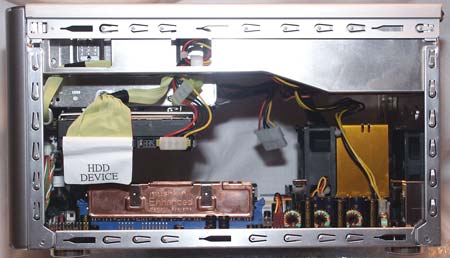
The 2 Dual-Channel DIMM sockets are also accessible from the right side, making it easy to swap memory in the iDEQ 200T without disassembling the SFF computer. This is a much better solution than other designs that place the memory slots parallel to the front. That arrangement, used by many competitors, often requires removing the drive cage just to change DIMMs. Most other designs come with prepared cables that you will need to route according to directions before installing drives. The Biostar came with all cable preinstalled, cleverly routed, and clearly labeled. In fact, the iDEQ 200 is the first SFF where we could actually install all the drives, memory, and CPU without having to remove the drive cage.
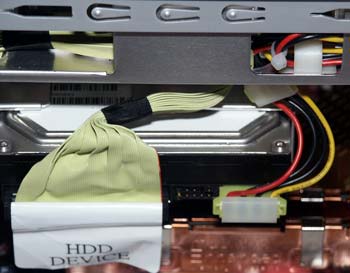
You will have to loosen a large screw and slide out the hard drive cage to mount the hard drive, but this is a simple release of the right catch on the sliding HD tray. Biostar also tells us that there is an optional dual hard drive cage for those who wish to use RAID with the Intel ICH5R Southbridge. Please contact Biostar for more information on the dual-drive cage.
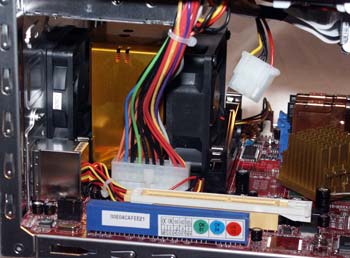
The cooling system for the Biostar consists of a variable speed large 80 cm rear-facing CPU fan blowing over copper fins covering heatpipes mounted on a copper plate, which cover the CPU. Hot air is then exhausted just behind the CPU cooling module with another rear mounted System fan. The iDEQ 200T cooling solution was very effective in our tests. We set fans on “Smart Fan” to vary speed as needed to keep the unit quiet. Not once during our testing did Smart Fan turn on the fan high setting in our air-conditioned lab.

The attention to a total cooling solution even extends to the aluminum bottom of the Biostar iDEQ 200T, where the depressions are designed to mate with the locations of the CPU, Northbridge and Southbridge. Effectively, this turns the bottom of the case into a giant heatsink.
If you would like to know more about how the Biostar cooling system works, check out the additional information at Biostar.
The AGP and PCI slot can be fully accessed even with a fully loaded system.

Installation of a Biostar is the easiest that we have ever seen on an SFF with all of the pre-installed and pre-routed cabling. However, if you haven’t mounted cards before in an SFF, the arrangements will not seem very intuitive. Biostar’s design is very similar to the very efficient one pioneered by Shuttle. As you can see in the above photo of the very similar Shuttle card cage, 2 screws secure the slots. You must remove both screws and flip up the hinged top cover by pushing out from the inside of the case just above the slots. You can then easily add or remove a PCI or AGP card.
The iDEQ 200T design is both flexible and easily adapted to your needs. The attention to detail is superb. We had the Biostar out of the box, assembled and running faster than any SFF that we have previously tested. The pre-installed cabling combined with the hard drive slide meant that we could assemble the Biostar without removing the cage or having to route any cables. Biostar deserves congratulations for delivering the easiest to set-up SFF on the market.










23 Comments
View All Comments
Anonymous User - Monday, October 6, 2003 - link
http://www.sfftech.com/showdocs.cfm?aid=442Even nicer!
Anonymous User - Sunday, October 5, 2003 - link
Be warned. They still need to work on the power supply for these systems. I own a Shuttle, and basically had to rip out the crappy 200W PSU and use an external 350W PSU (probably 300W may have been enough). With the stock PSU, the system would basically hang after any kind of intensive activity (try a stress test on the system for an hour or so).These systems overdrive the PSU, and while you will hear stories of people running 17 harddrives and their latest ATI Bongo 945600 on an overclocked box -- those are very much the exceptions. You either have to hook up a better PSU externally -- basically invalidating the whole purpose behind a SFF in the first place, or you have to play roulette with reordering 200W PSUs until you get a particular item which may work overdriven (but for how long?)
I see SHuttle has 220W PSU's in their newer versions, which should help.. but considering that people run the same hardware with 350W PSU's in bigger boxes, I still remain *very* suspicious of their claims.
Wesley Fink - Saturday, October 4, 2003 - link
#11 - The Shuttle and Biostar are the same size. A review will be posted shortly on the Soltek SFF which is a bit taller and has 2-5.25" bays and a 250W PS. I've included a picture of the Soltek and Biostar side-by-side in that review.#20 - As you can see on the Shuttle and Biostar Forums on some boards, users have been modifying these machines. You are correct that the internal USB headers have no matching punch-out for an external header, but most USB connectors are on slot brackets and you could certainly get a 4-port slot bracket for one of the two slots in the rear. Also you could use a hard-drive where the floppy goes - just be very careful of heat build-up. It should work fine.
Anonymous User - Friday, October 3, 2003 - link
Can someone explain to me what "internal" USB ports are for? I note the sb65g2 has a total of 6 ports (4 rear, 2 front) while the 200t has 4 (2 rear, 2 front). But the article says the 200t has 4 more "internal" USB ports, and the sb65g2 has 2 more internally. There's no breakout (that I noticed) for adding more external ports using a header (like the parallel port header allows), so what good are internal ports?Also, is there any reason why one could not put a second hard drive where the floppy goes, like one can do in the sb65g2?
(I'm really torn between the two machines!!! Grrr.)
Anonymous User - Thursday, October 2, 2003 - link
I would like to upgrade from my present SFF (ASUS Terminator) but want to install dual HDs. Your review mentioned an optional dual HD cage. Any info available on where this might be found. Typically I've found that optional items on SFF machines are not available (except maybe in Taiwan).hirschma - Wednesday, October 1, 2003 - link
Post #10 - perhaps you _should_ test the SPDIF input. That was the problem when I bought the Biostar 200N - Biostar said that it had input, every reviewer said the same... turns out that it was on Biostar's spec page, and every reviewer just took their word for it.Would your review be so glowing if it turned out that a major feature for some wasn't really there?
Don't reviewers have some responsibility to ensure that all advertised features actually are present?
It ain't that hard to test - hook up your PS2 or similar, and see if it passes audio, no?
rhacquer - Tuesday, September 30, 2003 - link
Oh, I got the jones for a SFF rig now... soon as we put on a new roof, pay for baby's private school, replace my 12 yr old car, etc. :-(Anonymous User - Tuesday, September 30, 2003 - link
post # 14 - SIZEAnonymous User - Tuesday, September 30, 2003 - link
50 Dba is twice as loud as 40Dba, not 10x as much.Anonymous User - Tuesday, September 30, 2003 - link
fill me in on the power supply .. why are the sff's 200 watts versus pc at 450 or so? why so much less power?